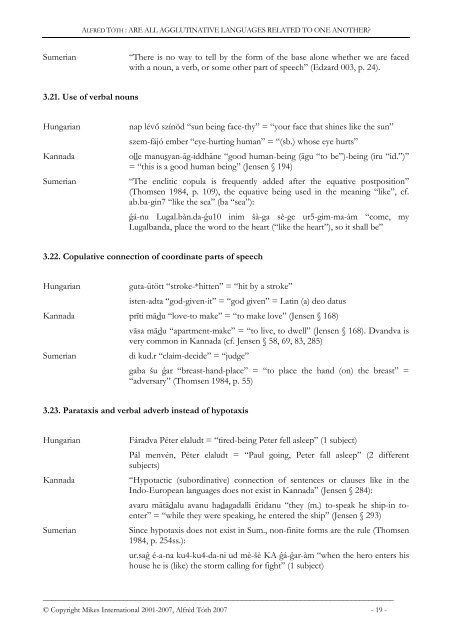Are all agglutinative languages related to one another?
Are all agglutinative languages related to one another?
Are all agglutinative languages related to one another?
Create successful ePaper yourself
Turn your PDF publications into a flip-book with our unique Google optimized e-Paper software.
ALFRÉD TÓTH : ARE ALL AGGLUTINATIVE LANGUAGES RELATED TO ONE ANOTHER?<br />
Sumerian “There is no way <strong>to</strong> tell by the form of the base al<strong>one</strong> whether we are faced<br />
with a noun, a verb, or some other part of speech” (Edzard 003, p. 24).<br />
3.21. Use of verbal nouns<br />
Hungarian nap lévő színöd “sun being face-thy” = “your face that shines like the sun”<br />
szem-fájó ember “eye-hurting human” = “(sb.) whose eye hurts”<br />
Kannada olle manusyan-āg-iddhāne “good human-being (āgu “<strong>to</strong> be”)-being (iru “id.”)”<br />
= “this is a good human being” (Jensen § 194)<br />
Sumerian “The enclitic copula is frequently added after the equative postposition”<br />
(Thomsen 1984, p. 109), the equative being used in the meaning “like”, cf.<br />
ab.ba-gin7 “like the sea” (ba “sea”):<br />
ĝá-nu Lugal.bàn.da-ĝu10 inim šà-ga sè-ge ur5-gim-ma-àm “come, my<br />
Lugalbanda, place the word <strong>to</strong> the heart (“like the heart”), so it sh<strong>all</strong> be”<br />
3.22. Copulative connection of coordinate parts of speech<br />
Hungarian guta-ütött “stroke-*hitten” = “hit by a stroke”<br />
isten-adta “god-given-it” = “god given” = Latin (a) deo datus<br />
Kannada prīti mādu “love-<strong>to</strong> make” = “<strong>to</strong> make love” (Jensen § 168)<br />
vāsa mādu “apartment-make” = “<strong>to</strong> live, <strong>to</strong> dwell” (Jensen § 168). Dvandva is<br />
very common in Kannada (cf. Jensen § 58, 69, 83, 285)<br />
Sumerian di kud.r “claim-decide” = “judge”<br />
gaba šu ĝar “breast-hand-place” = “<strong>to</strong> place the hand (on) the breast” =<br />
“adversary” (Thomsen 1984, p. 55)<br />
3.23. Parataxis and verbal adverb instead of hypotaxis<br />
Hungarian Fáradva Péter elaludt = “tired-being Peter fell asleep” (1 subject)<br />
Pál menvén, Péter elaludt = “Paul going, Peter f<strong>all</strong> asleep” (2 different<br />
subjects)<br />
Kannada “Hypotactic (subordinative) connection of sentences or clauses like in the<br />
Indo-European <strong>languages</strong> does not exist in Kannada” (Jensen § 284):<br />
avaru mātādalu avanu hadagad<strong>all</strong>i ēridanu “they (m.) <strong>to</strong>-speak he ship-in <strong>to</strong>enter”<br />
= “while they were speaking, he entered the ship” (Jensen § 293)<br />
Sumerian Since hypotaxis does not exist in Sum., non-finite forms are the rule (Thomsen<br />
1984, p. 254ss.):<br />
ur.saĝ é-a-na ku4-ku4-da-ni ud mè-šè KA ĝá-ĝar-àm “when the hero enters his<br />
house he is (like) the s<strong>to</strong>rm c<strong>all</strong>ing for fight” (1 subject)<br />
___________________________________________________________________________________<br />
© Copyright Mikes International 2001-2007, Alfréd Tóth 2007 - 19 -

















